The Spooky Stories Behind Katsushika Hokusai’s Famed Woodblock Prints
By Something CuratedHyakumonogatari Kaidankai is a Japanese tradition in which people gather at night to exchange eerie ghost stories and personal anecdotes. This game involves the sequential telling of stories, with illumination provided by a hundred candles. After each tale, a candle is extinguished, gradually plunging the surroundings into deeper darkness. Originally, the game served as a test of bravery among samurai, but its popularity quickly spread. Despite being primarily known for his depictions of landscapes and wildlife, Japanese Edo period artist Katsushika Hokusai (1760-1849), in his later years, delved into the supernatural beliefs prevalent during the Edo period. One Hundred Ghost Stories is a mesmerising collection of ukiyo-e woodblock prints created by Hokusai in the early 1830s. These prints belong to the Yūrei-zu genre and were created alongside Hokusai’s renowned Thirty-six Views of Mount Fuji series. Hokusai, along with the publisher Tsuruya Kiemon, envisioned a comprehensive collection of ghoulish works, intended to consist of one hundred prints, but only five were completed before the artist’s passing.
The Laughing Hannya
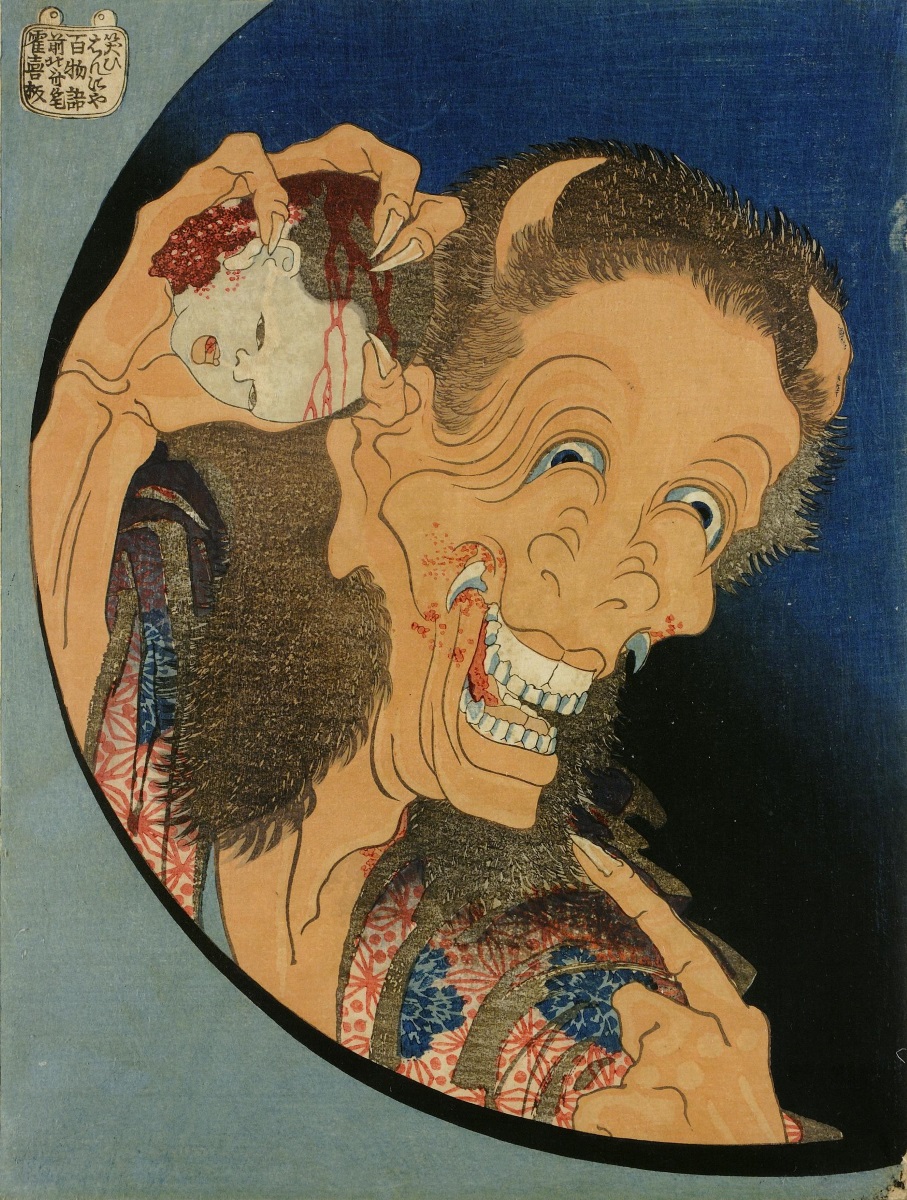
In this particular print, Hokusai skilfully merges two mythical creatures from folklore: the hannya, an elderly woman believed to transform into a demon due to intense jealousy, and the yamanba, a malevolent being known for devouring abducted children. The artwork vividly depicts the monstrous entity revelling in its diabolical feast, devouring an innocent, live infant. This tale originates from the folklore of the Nagano region. The creature in question, often referred to as the Warai-hannya or Laughing Demoness, embodies an ogress-like persona. Hokusai introduces a visual division within the painting, utilising a crescent arc as a symbolic boundary between the human realm and the supernatural domain of ghosts. This composition technique is reminiscent of Hokusai’s earlier landscape prints such as the View from Massaki of Suijin Shrine, Uchigawa Inlet, and Sekiya, 1857. The plain backdrop resembles a wall, while the circular frame containing the demon acts as a window, connecting the viewer with the outside world. By placing the hannya outside of this window-like frame, Hokusai effectively brings the creature into the viewer’s everyday life, establishing a sense of unsettling proximity.
The Plate Mansion
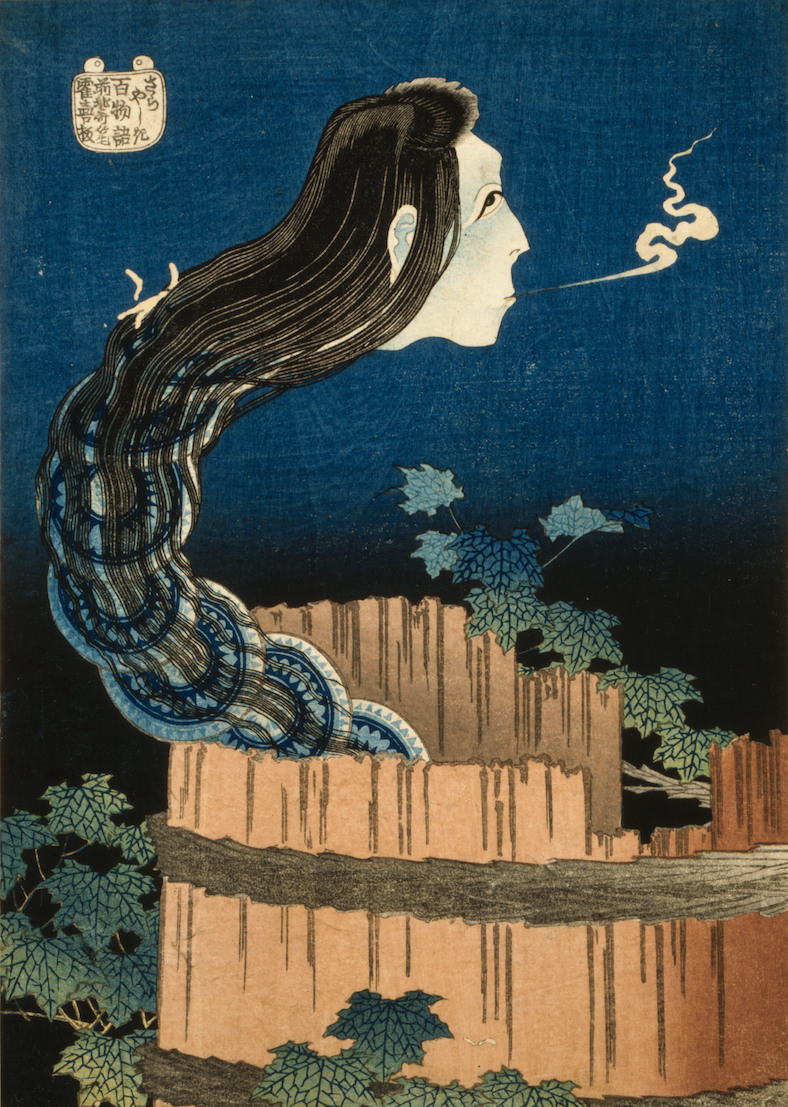
During the 17th century, a legend emerged, recounting the misfortune of a maid named Okiku, who accidentally shatters a precious set of Korean plates. The subsequent events of this tale vary slightly across different versions. In one rendition, her master casts her into a well, while another version suggests that Okiku, overwhelmed by despair, chooses to end her life. As she meets her tragic fate within the well, she undergoes a transformation into a Yūrei, a vengeful ghost. An alternate version portrays Okiku as an employee of Aoyama Tessan, a samurai from Himeji Castle. When he makes unwanted advances towards her and faces rejection, Aoyama resorts to a deceitful scheme, falsely accusing Okiku of losing one of the valuable plates. He manipulates the situation, offering her forgiveness only if she becomes his lover. Her unwavering refusal leads Aoyama to cruelly throw Okiku into a well. Consequently, she returns as a ghostly apparition, compelled to count the plates incessantly each night. The most widely accepted version of this tale emerged in 1795, during a period when Japan experienced an infestation of a specific type of worm that infested old wells, earning the moniker “Okiku bug.”
The Ghost of Kohada Koheiji
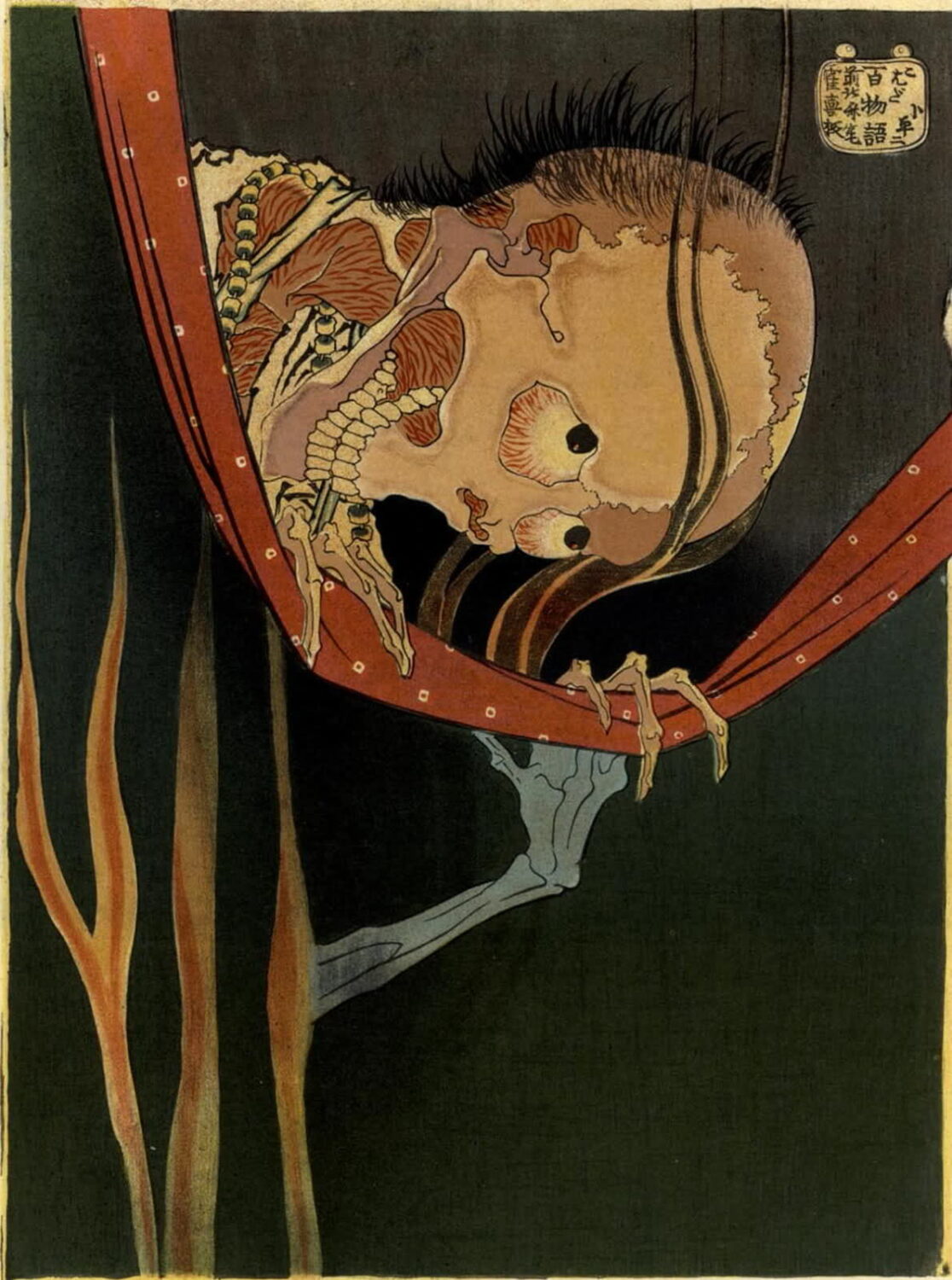
This print captures a moment from a Japanese legend centred around a man who met a tragic fate, drowned in a marsh by his own wife and her lover. Kohada Koheiji initially worked as a kabuki actor at the Morita-za theatre. Struggling to secure substantial roles, he was eventually typecast as a ghost, limiting his opportunities within the playhouse. Filled with embarrassment, his wife, Otsuka, conspired with her lover, a fellow actor named Adachi Sakuro, to carry out the murder of her husband. They disposed of his lifeless body in a swamp. However, in a chilling turn of events, Kohada returns from the realm of the dead, driven by a relentless desire for revenge. The artwork portrays a skeletal ghost engulfed in flames, eerily confronting the couple while they lie together in bed beneath a mosquito net. The writer Santō Kyōden, also known as the ukiyo-e artist Kitao Masanobu, further developed the tale of Koheiji in his 1803 novel, Bizarre Tale of Revenge at Asaka Marsh. The narrative drew inspiration from actual events, as Kohada Koheiji was a real victim of murder. Subsequently, in 1808, the story was adapted for the stage.
The Ghost of Oiwa
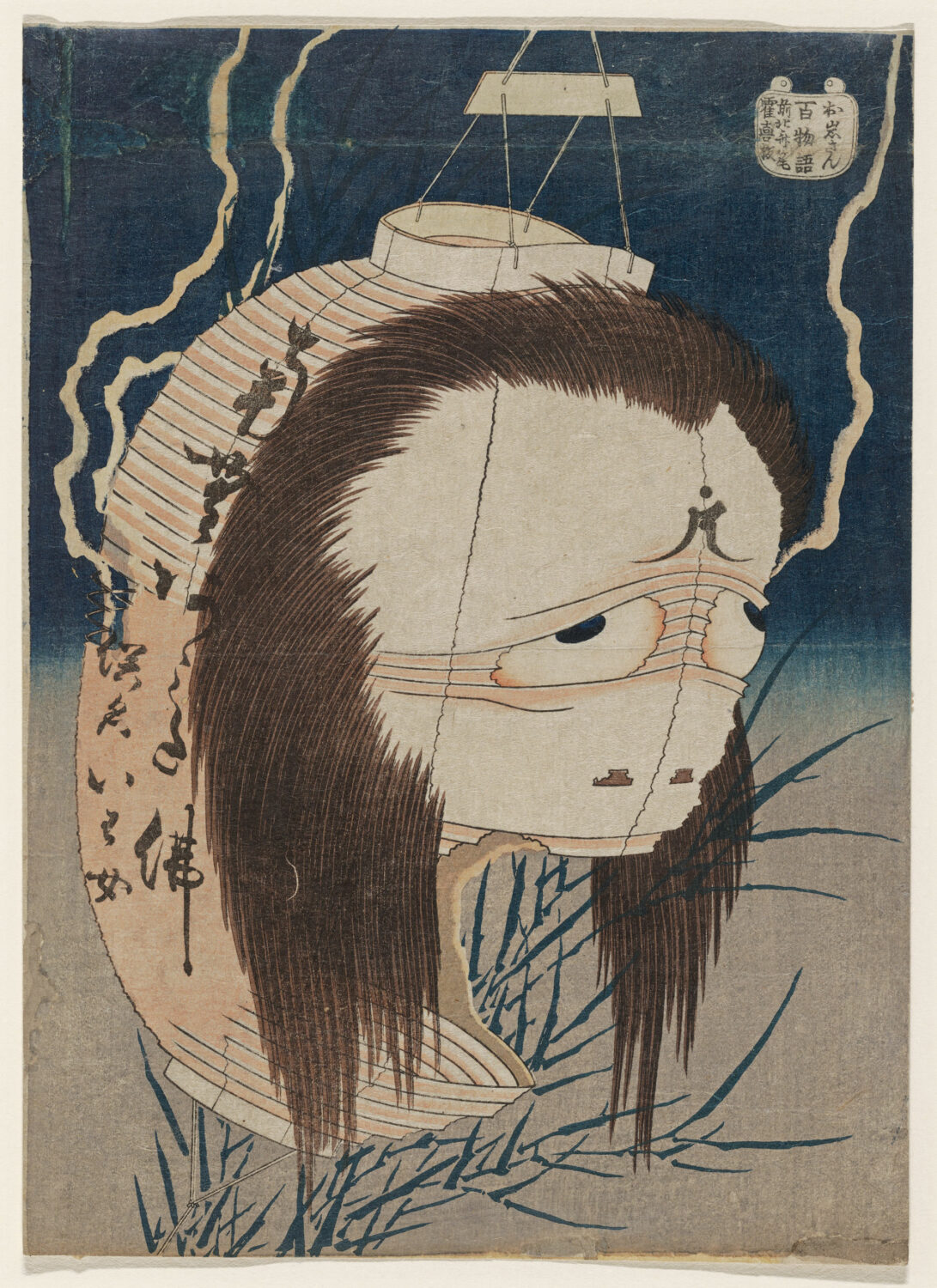
Originally conceived as a kabuki theatre play titled Yotsuya Kaidan, the story dates back to 1825 and was penned by Tsuruya Nanboku IV. Multiple versions of this tale have emerged over time, but the most widely recounted rendition unfolds as follows: a young girl named Oume becomes enamoured with Tamiya Iemon, a samurai who is already married. Oume’s friends conspire to eliminate Iemon’s wife, Oiwa, by presenting her with a poisonous face cream. Although the cream fails to claim Oiwa’s life, it horribly disfigures her face. Eventually, Iemon, repulsed by his mutilated spouse, heartlessly abandons her, plunging her into madness fuelled by grief. In her frenzied state, she accidentally trips and falls onto an exposed sword, meeting her tragic demise. With her dying breath, she curses Iemon, embarking on a spectral journey to haunt him in various forms, including that of a paper lantern.
Obsession
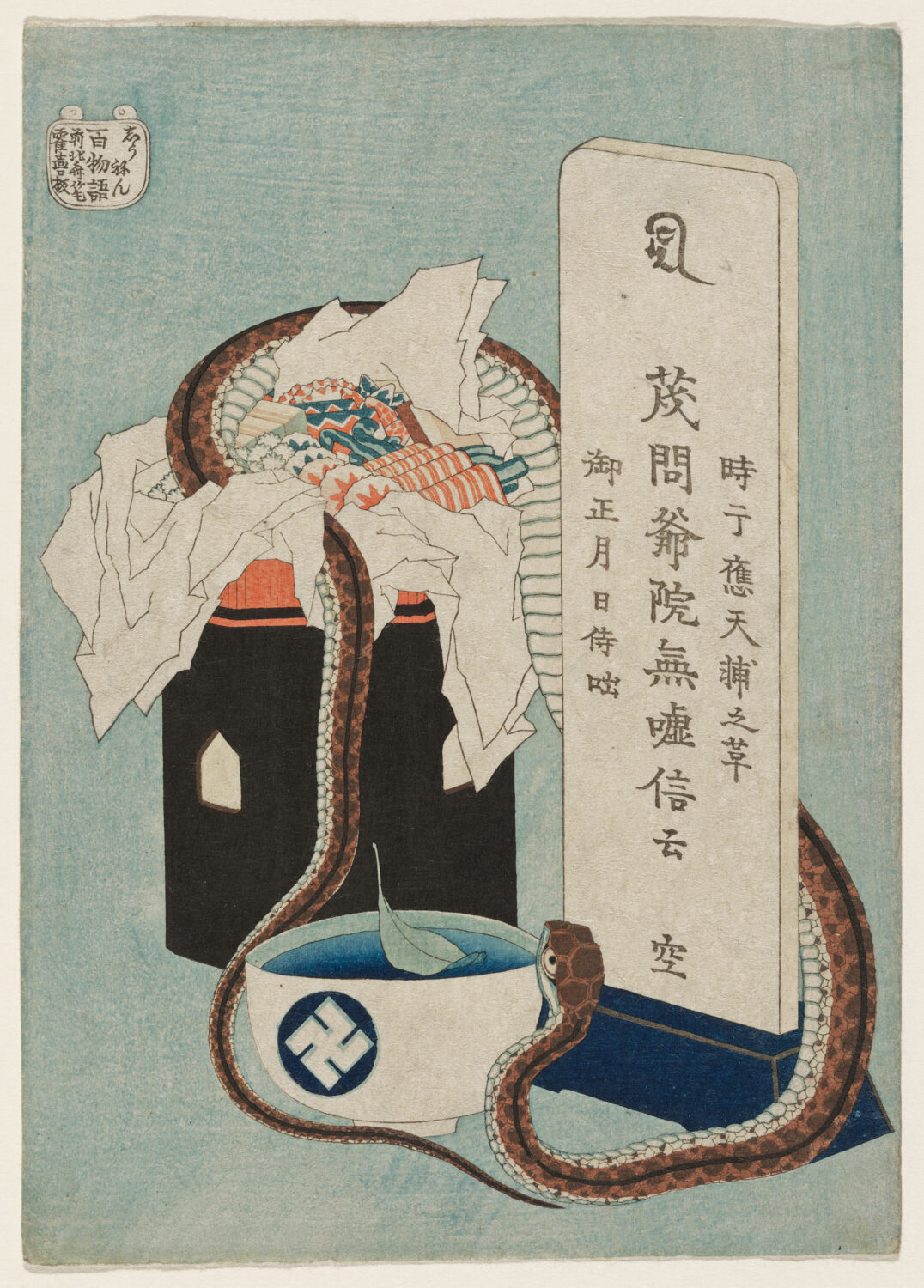
This work portrays a snake coiled around a Buddhist memorial tablet, typically placed on an altar to honour the deceased. The snake symbolises an enduring obsession that persists even after death. During the Edo period in Japan, snakes often appeared in stories as the transformed spirits of the departed. Frequently, they embodied the lingering spirits of women who had passed away consumed by jealousy, resentment, or contempt. However, in this instance, it is believed that the spirit of obsession depicted here represents the artist Hokusai himself, foretelling his unwavering dedication to his art even beyond the grave. The memorial tablet dates from 1831 to 1845, a period marred by the Tenpō famine, which claimed the lives of many in Japan. The inscription in the middle identifies the posthumous name bestowed upon the Buddhist figure known as Momonji, a demonic entity depicted as an aged bestial man who assaults travellers on dark roads. Additionally, the presence of a Buddhist swastika, known as the manji in Japanese, on the bowl holds significance as Hokusai utilised it as a pseudonym. Hence, an alternative interpretation suggests that the departed figure represents Hokusai himself, whose fervent preoccupation with the supernatural realm has transformed him into a paranormal being.
Feature image: The Ghost of Oiwa (Oiwa-san) by Katsushika Hokusai